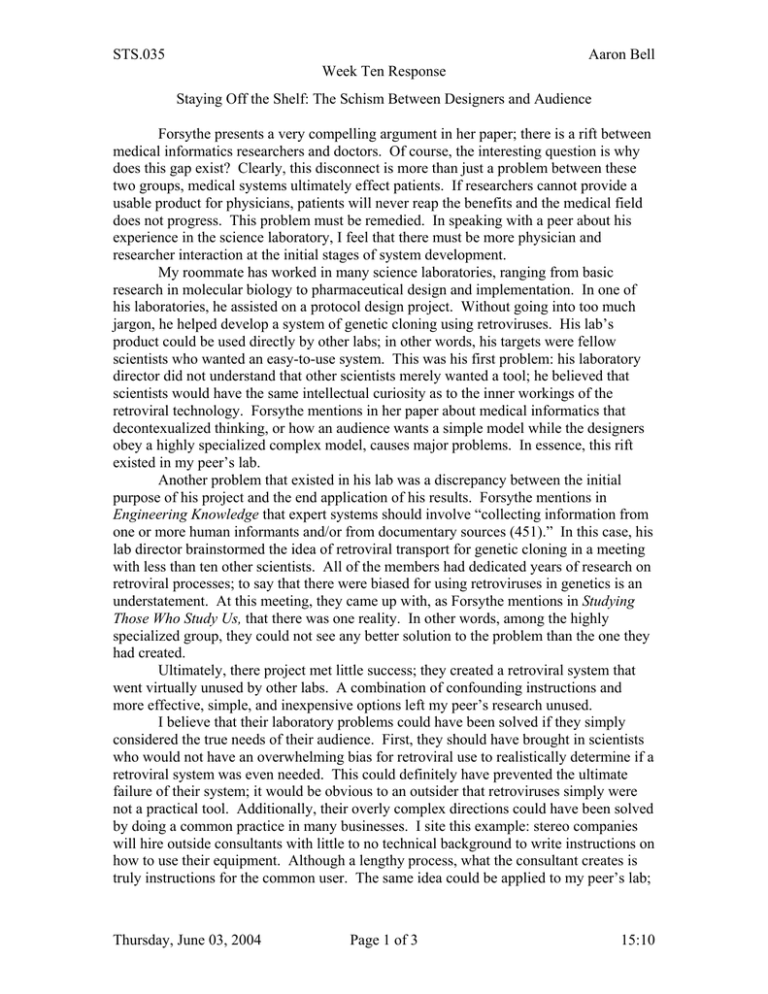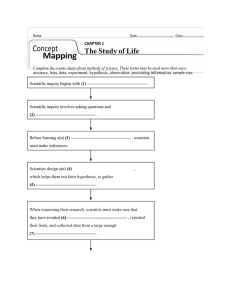STS.035 Aaron Bell
advertisement

STS.035 Aaron Bell Week Ten Response Staying Off the Shelf: The Schism Between Designers and Audience Forsythe presents a very compelling argument in her paper; there is a rift between medical informatics researchers and doctors. Of course, the interesting question is why does this gap exist? Clearly, this disconnect is more than just a problem between these two groups, medical systems ultimately effect patients. If researchers cannot provide a usable product for physicians, patients will never reap the benefits and the medical field does not progress. This problem must be remedied. In speaking with a peer about his experience in the science laboratory, I feel that there must be more physician and researcher interaction at the initial stages of system development. My roommate has worked in many science laboratories, ranging from basic research in molecular biology to pharmaceutical design and implementation. In one of his laboratories, he assisted on a protocol design project. Without going into too much jargon, he helped develop a system of genetic cloning using retroviruses. His lab’s product could be used directly by other labs; in other words, his targets were fellow scientists who wanted an easy-to-use system. This was his first problem: his laboratory director did not understand that other scientists merely wanted a tool; he believed that scientists would have the same intellectual curiosity as to the inner workings of the retroviral technology. Forsythe mentions in her paper about medical informatics that decontexualized thinking, or how an audience wants a simple model while the designers obey a highly specialized complex model, causes major problems. In essence, this rift existed in my peer’s lab. Another problem that existed in his lab was a discrepancy between the initial purpose of his project and the end application of his results. Forsythe mentions in Engineering Knowledge that expert systems should involve “collecting information from one or more human informants and/or from documentary sources (451).” In this case, his lab director brainstormed the idea of retroviral transport for genetic cloning in a meeting with less than ten other scientists. All of the members had dedicated years of research on retroviral processes; to say that there were biased for using retroviruses in genetics is an understatement. At this meeting, they came up with, as Forsythe mentions in Studying Those Who Study Us, that there was one reality. In other words, among the highly specialized group, they could not see any better solution to the problem than the one they had created. Ultimately, there project met little success; they created a retroviral system that went virtually unused by other labs. A combination of confounding instructions and more effective, simple, and inexpensive options left my peer’s research unused. I believe that their laboratory problems could have been solved if they simply considered the true needs of their audience. First, they should have brought in scientists who would not have an overwhelming bias for retroviral use to realistically determine if a retroviral system was even needed. This could definitely have prevented the ultimate failure of their system; it would be obvious to an outsider that retroviruses simply were not a practical tool. Additionally, their overly complex directions could have been solved by doing a common practice in many businesses. I site this example: stereo companies will hire outside consultants with little to no technical background to write instructions on how to use their equipment. Although a lengthy process, what the consultant creates is truly instructions for the common user. The same idea could be applied to my peer’s lab; Thursday, June 03, 2004 Page 1 of 3 15:10 STS.035 Aaron Bell Week Ten Response if they asked a scientist who wasn’t a virologist, they could have created a usable set of directions. It is clear that change has to be made in the process of product design. I used the above example as an outlier; my peer worked in lab with scientists that were designing a product for other scientists. If a gap exists between those in the same profession, undoubtedly an even larger hole exists between scientists and the average audience. Of course, to ask designers to shoulder the entire responsibility of creating a usable system is unrealistic. If a group needs something, they should much more active in seeking out designers. The audience needs to think ahead and create a list of what they require; then they can work with designers on refining a patented system. If design scientists considered at an early stage the opinions and needs of their audience and the audience in turn pursues the designers, more usable advanced systems could be created without the risk of being committed “to the shelf.” Thursday, June 03, 2004 Page 2 of 3 15:10 STS.035 Aaron Bell Week Ten Response Works Cited: Forsythe, Diana E. “Engineering Knowledge: The Construction of Knowledge in Artificial Intelligence.” Social Studies of Science 23 (1993): 445-477. Forsythe, Diana E. “Blaming the User in Medical Informatics: The Cultural Nature of Scientific Practice.” In Studying Those Who Study Us: An Anthropologist in the World of Artificial Intelligence (Stanford, CA: Stanford University Press, 2001), pp. 1-15. Thursday, June 03, 2004 Page 3 of 3 15:10




